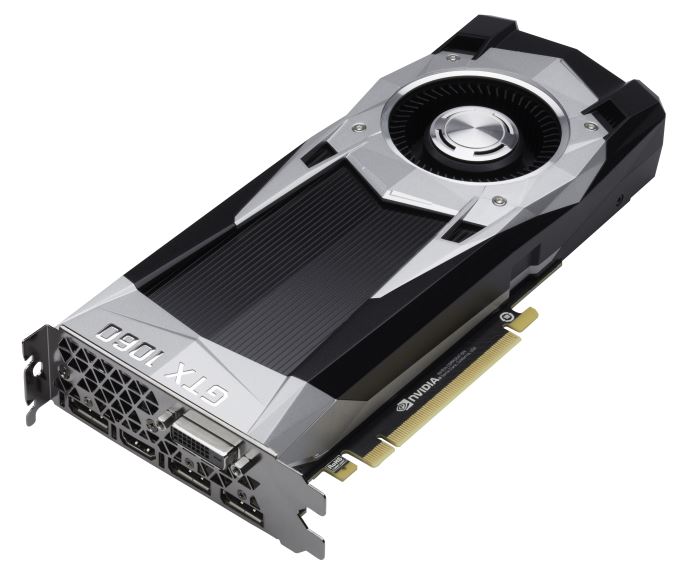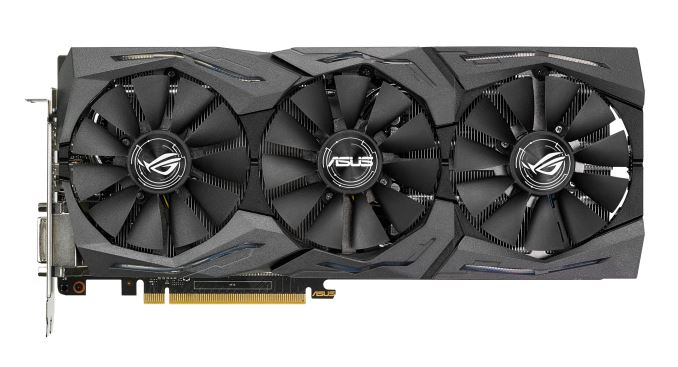The GeForce GTX 1060 Founders Edition & ASUS Strix GTX 1060 Review
by Ryan Smith on August 5, 2016 2:00 PM ESTFinal Words
Bringing this review to a close, while in the big picture we’re still early in the release cycle of the FinFET generation of video cards, the launch of the GeForce GTX 1060 and its underlying GP106 GPU none the less marks an important turning point in this release cycle. While NVIDIA and AMD were content to initially chase different markets with their respective first product releases – going after the high-end and mainstream markets respectively – now that NVIDIA is further fleshing out their product stack, NVIDIA and AMD can no longer avoid each other. So for the first time in this generation we have some real competition, and importantly for so many gamers out there it takes place in the higher volume mainstream market.
Overall, GeForce GTX 1060 follows a string of well executed NVIDIA launches throughout the Maxwell and now Pascal generations, and GTX 1060 is no different. NVIDIA has continued to focus on balancing performance with power consumption, and the end result is that like its bigger siblings, GP106 and GTX 1060 follow this trend to a T.
Relative to GeForce GTX 1070, GTX 1060 delivers 73% of the performance of NVIDIA’s enthusiast level card. In practice this puts GTX 1060 a bit closer to GTX 1070 than GTX 960 was to GTX 970 last year; the performance gap between these tiers is a bit narrower, likely as a result of the fact that the gap between GTX 1070 and GTX 1080 is greater. The end result, then is that GTX 1060 offers 73% of the performance for what’s (on paper) 66% of the price. Consequently, buyers looking for GTX 1060 to radically alter the price/performance curve of this generation may come away with less than they hoped for, but mainstream gamers looking for a cheaper Pascal card finally have an option.
Looking at generational comparisons then, of all of the Pascal cards launched so far, GTX 1060 offers the best performance gains for a single generation. Relative to GTX 960 it offers an 85% performance improvement at 1080p, and even excluding the outliers this is still an 80% gain. This isn’t quite a 2x performance gain in a single generation, but it is close, and closer than either GTX 1070 or GTX 1080 got. So for current GTX 960 owners, the GTX 1060 offers a tantalizing performance upgrade right off the bat, and for the older GTX 760 and GTX 660 cards the differences are even greater, never mind the newer features NVIDIA has introduced since Kepler.
The one catch to all of this is price. Relative to GTX 960 prices for this generation have gone up, from $199 for GTX 960 to $249 for GTX 1060. This is still on the edge of the mainstream video card market (if only barely so) and it’s a price NVIDIA has sold GTX x60 cards at before, but it means that NVIDIA misses out on the $200 sweet spot right now. Instead what they offer is essentially a greater than previous generational performance increase for a greater than previous price.
As for where the previously mentioned competitive landscape fits in, a lot of it is going to depend on what potential buyers are looking to spend. At the GTX 1060’s MSRP of $249, the card is countered by AMD’s Radeon RX 480 8GB for $239. The RX 480 is a very capable card, but the launch of the GTX 1060 puts an end to AMD’s short-lived exclusive to that market. And to NVIDIA’s credit (and AMD’s chagrin), the GTX 1060 is 12% faster while consuming less power at the same time, more than justifying the $10 price difference and giving NVIDIA a legitimate claim as the superior GPU.
That said, pricing makes all the difference. While GTX 1060’s principle competition is the 8GB RX 480, AMD also launched a 4GB RX 480 specifically to hit the $199 price point and to be a spoiler here. Based on what we’ve seen in the past, I am concerned that a 4GB high-end 1080p card is at risk of being VRAM limited too early in its lifetime. But if that’s something that doesn’t bother you, then the 4GB RX 480’s much lower price makes it a very viable alternative to the GTX 1060 for buyers who need similar performance for a lower price. That is, of course, if you can get a 4GB RX 480.
And this brings up perhaps the most difficult issue for any video card buyer right now, AMD or NVIDIA: supply. Partners for both vendors are regularly restocking video cards, but it’s still not enough, and cards are selling almost as fast as they can be listed. The good news for the GTX 1060 is that post-launch card prices haven’t really gone up, so if you can find a card you’ll likely find it at (or close to) that specific card’s MSRP. But it means you have to find a card in the first place. Of course the video card market is no stranger to launch shortages, but this generation is proving unique in just how long so many different cards are in short supply. On that note, this is also why I don’t consider the 4GB RX 480 a greater spoiler for the GTX 1060; of all of the mainstream cards on the market, it’s the hardest to get, as vendors favor producing higher margin 8GB cards. Consequently, if you want a mainstream card right now, your only viable options are the much more closely priced GTX 1060 and 8GB RX 480.
In any case, it goes without saying that all of the above buying suggestions are based on cards being on the market at or close to their MSRPs. If card prices do finally slip, then all of this goes out the window.
Finally, let’s talk about where the individual GTX 1060 cards we reviewed today fit into the broader picture. With their Founders Edition cards NVIDIA has set out to create what amounts to their own brand for premium video cards, and it’s working. Like the GTX 1080 and 1070 Founders Edition cards before it, the GTX 1060 Founders Edition is a well-built, well-performing card. But with otherwise reference gaming performance, it’s not an easy card to recommend given its $50 (20%) price premium. If you need or want a blower style card then it’s a solid choice, otherwise as nice as the card is, the cheaper vendor custom cards still look very attractive.
As for ASUS’s ROG Strix GeForce GTX 1060 OC, ASUS has gone for premium market and it shows. Everything from the overbuilt cooling and power delivery system to the RGB lighting and factory overclock put it a step above the other cards, including NVIDIA’s own Founders Edition. However this also contributes to its drawback, which is its price. Which is not to say that there isn’t a place in the market for premium cards – that they are so popular with gamers is clear proof that there is – but ASUS is clearly playing in a niche market with a $314 GTX 1060. For those buyers who can pay ASUS’s price premium, I have no doubt they’ll be happy with the card. Otherwise the mainstream masses will want to look elsewhere, as this isn’t a card aimed at them.












189 Comments
View All Comments
Greeba77 - Wednesday, August 10, 2016 - link
I don't subscribe to some of the bitchier comments on here and I do read Anandtech because of the depth of the reviews. I do feel a trick or two has been missed on this one, because since the 1080 and 1070 review, the results came out elsewhere to show the low level API performance on the Pascal cards seemed to be a problem (the Vulkan Doom benchmarks were awful compared to the RX480). I was hoping this review would include a deeper dive in to this as it's a potential question mark on the 1060's future proofing vs the RX480.Thermalzeal - Monday, August 15, 2016 - link
I will please ask that you use "other" review sites for your insatiable impatient needs.No way AnandTech will be left out because it's the only site that Industry professionals actually read these days. And if for some reason this catastrophe happened...I'm pretty sure one call to Anand, and he'll walk right into Jen Hsun's office and take the card right out of his computer. Especially now that he's just hanging out at Apple. ,
Colin1497 - Friday, August 5, 2016 - link
Clearly the last couple months have been unfortunate, as whatever dynamic has happened has corresponded with the most exciting time in the GPU world in years. The question is where he can get back on track. I doubt that Ryan is unaware of all of the issues surrounding this. We will see how he responds. :)just4U - Saturday, August 6, 2016 - link
100% certain he's aware of the criticisms.. as he does comment on some of them. Also a likely reason why Daniel Williams was brought on board to help with overflow.. Although I'd really like to see Ian take a stab at the video card reviews.. (just for sh... and giggles) as processors are not so interesting these days with incremental bumps... but they all have their niche areas to work with so whatever.The only real criticism I have would be the waiting game.. If Ryan says something will be ready on a certain date (or in a few days..) and then it takes weeks.. well shoot that's disappointing and shouldn't happen. But hey.. I was one of those happy with the Preview the Review was just icing on the cake (even if I disagree on the 480 vs 1060 assessment)
Ryan's good at what he does late or not, many of us look forward to Anandtech's takehome on new Video Cards.
ridic987 - Sunday, August 7, 2016 - link
what about his 480 vs 1060 assessment do you disagree with?just4U - Monday, August 8, 2016 - link
He puts it at and around 10% faster than the RX480. The feel I am getting from most who have hands on experience with both cards suggest the 480 might be a little better.It reminds me of the 380/960 comparisons online initially.. both excellent products overall but after a lot of time with both I kind of felt ripped off by the 960 which I paid a premium for and it certainly wasn't as good as the 380.
Cygni - Friday, August 5, 2016 - link
Then go start your own review website, nerd. This one ain't yours, and nobody cares about how you think it should be run.Devo2007 - Friday, August 5, 2016 - link
Actually, very few (if any) sites were sampled Titan X Pascal cards - has nothing to do with Anandtech's review schedule.Nagorak - Saturday, August 6, 2016 - link
They didn't sample anyone on Titan X it seems like.Tabalan - Friday, August 5, 2016 - link
What about RX470? It would be nice to see some decent AIB cards compared. Also, I really would like you to add 2 charts in summary - overall performance and perf/$. This would help comparing your review to other reviews without going though all benchmarks and game tests.